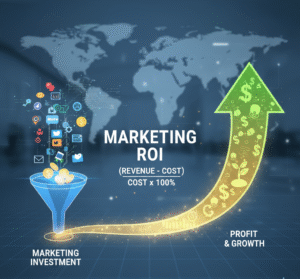Marketing ROI (return on investment) is a performance metric that shows how much profit or revenue you earn for each marketing dollar spent. For example, a 5:1 ROI means you earned $5 for every $1 invested. Importantly, ROI helps small businesses and startups see which campaigns truly pay off and where to invest next. By measuring ROI, you know which efforts drive real sales, so you can adjust your budget and strategy as needed. In this guide, we explain what marketing ROI is, why it matters, key formulas, useful tools, and tips for accurate measurement.
What is Marketing ROI?

Marketing ROI compares the revenue (or profit) from your marketing efforts to the cost of those efforts. In simple terms, it answers: “For every dollar spent on marketing, how much revenue did we get?”. In other words, it quantifies the financial return of your campaigns. For instance, if you spend $100 on an ad and it generates $300 in sales, your ROI is (300–100)/100 = 200%. This shows the campaign tripled the initial spend. Also, ROI can be expressed as a ratio (e.g. 3:1) or a percentage (200%). Measuring ROI turns marketing from “activity” to money in the bank: it tells you exactly if a campaign is making or losing moneysalesforce.com.
Why Marketing ROI Matters
- Proves marketing’s value. Marketing is often seen as a cost center until you show results. ROI ties marketing activities to real revenue. For example, saying “$20K spent generated $80K in sales (300% ROI)” is far more convincing than showing clicks or impressions alone.
- Guides smarter decisions. ROI data shows which channels and tactics work best. When you know which marketing activities have the highest return, you can invest more in them and cut underperforming ones. This is especially crucial for small businesses and startups with tight budgetsagencyanalytics.com.
- Defends your budget. Clear ROI figures help you justify marketing spending to stakeholders. In tough times or budget reviews, demonstrating ROI gives you a strong case for marketing investment.
- Improves strategy. Over time, tracking ROI across campaigns builds a track record. This lets you forecast results and focus on high-ROI activities (like the most profitable ad channels or content types).
Key Formulas to Calculate ROI
- Basic ROI: (Revenue – Cost) ÷ Cost. For example, if a campaign brings $10,000 in sales and cost $2,000 to run, ROI = ($10,000–$2,000) ÷ $2,000 = 4 (or 400%). This formula is simple and widely used.
- Cost Ratio: Revenue generated : Marketing dollars spent. For instance, a 5:1 ratio ($5 generated for $1 spent) equals 400% ROI. A higher ratio means better return (10:1 gives 900% ROI in the Oracle example).
- ROMI (Return on Marketing Investment): Similar to basic ROI but focused only on marketing. ROMI = (Revenue from Marketing – Marketing Cost) ÷ Marketing Cost.
- Other metrics: You might also consider Customer Lifetime Value (CLV), which measures the total revenue from a customer over time. Including CLV in your ROI (e.g. longer-term gains from repeat customers) gives a fuller picture of marketing impactoracle.com.
Tools That Can Help
- Web Analytics (Google Analytics): Tracks website visitors and conversions. Google Analytics is free and great if you sell products online. You can track sales by linking it to your shopping cart or by assigning values to website goals (forms, sign-ups).
- CRM and Marketing Platforms: Systems like Salesforce or HubSpot track leads and sales. They let you connect customer data to marketing activity. A CRM shows how campaigns convert into pipeline and customer value. Marketing automation tools (Marketo, Mailchimp, etc.) often include reports on campaign performance as well.
- ROI Tracking Software: Specialized tools (e.g. Ruler Analytics, Cyfe, Kissmetrics) provide dashboards and closed-loop attribution. For example, Cyfe is a business dashboard that integrates with ads, CRM, and finance apps to show campaign ROI in one place. These tools automate the math so you can see which channel brought each dollar of revenue.
- Spreadsheets: A simple Excel or Google Sheet can calculate ROI if you prefer manual control. It’s flexible for small budgets. Just list costs and revenues and apply the formulas above.
- Marketing Dashboards: Many all-in-one dashboards or BI tools let you combine data from multiple channels. They can automatically match sales to marketing sources. (For instance, they might attribute sales to specific ads or keywords to reveal actual ROI.) If you use such tools, they save time and improve accuracysalesforce.com.
Tips to Improve Accuracy
- Set clear goals and track the right metrics. Define what success means (sales, leads, signups, etc.) before starting a campaign. This helps you choose which numbers to include in ROI. Also establish your “break-even” point: how many sales are needed to cover your costs. Having precise goals keeps your ROI calculation focused and meaningful.
- Include all costs. Don’t forget indirect expenses: aside from ad spend, include creative development, software, labor, overhead, etc. Break down costs into categories (ads, content, staff, etc.) for detail. The more precise your cost data, the more accurate your ROI.
- Use detailed attribution. Avoid counting only the last click. For better accuracy, use multi-touch attribution or closed-loop tracking so all influencing channels get credit. If possible, integrate your analytics with sales data to match each sale to its original marketing source.
- Incorporate customer lifetime value (CLV). Some campaigns (like email marketing) have long-term value. Include CLV by estimating how much revenue a new customer brings over time. This ensures you don’t underestimate ROI for strategies that build loyalty.
- Test and update regularly. Compare your ROI calculations to actual results. For example, test your formula with past data to check for mistakes. Also update numbers periodically as costs or prices change. Tracking ROI over time helps spot trends and lets you adjust strategy mid-coursepersana.ai.
- Use reliable tools and first-party data. Sync your advertising and sales platforms (e.g. link Google Ads, Facebook Ads with your CRM). This prevents data gaps. Also use first-party data (customer info you collect directly) whenever possible to avoid biases from third-party cookies. Doing so improves accuracy by using the most complete data set.









